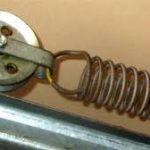Most common types of garage doors move up and down and their operation settings are adjusted to ensure the door reaches its opening and closing position. But this is not the only adjustment needed to make the door go all the way up and down. The combined efforts of garage door springs and cables play an important role too. They don’t only make sure of the door’s movement but balance too.
Garage door balance: what do we actually mean by that?
 Garage doors are balanced when their weight is equally divided to the two sides to provide an equilibrium of bear distribution that will not only make movement possible but ensure the straight movement of the door. In other words, the door will not tilt when opening up or leave an uneven gap when closed down.
Garage doors are balanced when their weight is equally divided to the two sides to provide an equilibrium of bear distribution that will not only make movement possible but ensure the straight movement of the door. In other words, the door will not tilt when opening up or leave an uneven gap when closed down.
The torsion and extension springs are the parts which are adjusted to provide proper garage door balance. And so when they become weak or too tensed, the door will either feel heavier or won’t close evenly.
Will extension or torsion spring adjustment fix the problem?
Well, yes and no. The truth is that most of the times all it takes to fix an unbalanced garage door is extensions or torsion spring adjustment. But beware. This is not always the case. Sometimes, the springs are too worn to be fixed and so better replaced. And oftentimes, other parts might be the reason for the problem too. Don’t forget that the counterbalancing system (springs) is connected to the garage door cables and tracks too. So it’s vital to make sure the tracks are aligned and nothing blocks the movement of the rollers. It’s also crucial to check that the cables are wrapped around the drum and are not loose.
unbalanced garage door is extensions or torsion spring adjustment. But beware. This is not always the case. Sometimes, the springs are too worn to be fixed and so better replaced. And oftentimes, other parts might be the reason for the problem too. Don’t forget that the counterbalancing system (springs) is connected to the garage door cables and tracks too. So it’s vital to make sure the tracks are aligned and nothing blocks the movement of the rollers. It’s also crucial to check that the cables are wrapped around the drum and are not loose.
But before you ever tamper with your garage door tracks, springs, and cables, you need to check the balance. And if it’s not okay, you need to see which side is out of balance.
How to test garage door balance
- Disconnect the door from the electric garage door opener – the door must be shut.
- Pull the door to open it manually. It should go up with ease and shouldn’t feel heavy. If you find any resistance, check if something obstructs the movement of the rollers. Otherwise, the door should open up free of hassle since the springs & cables still carry its weight.
- Open and close the door two-three times to make sure it doesn’t stick or bind. If it does, there might be a problem with the tracks.
- Then, open the door at your shoulder height and let go. If it is balanced, it will stay put. If not, it will either slide down or pop upwards. Either of these movements is an indication of wrong spring tension. Don’t panic if the door gently moves upwards or downwards a little bit. That’s normal. But if it makes an abrupt movement upwards or slams down, it is not good news. You should call a garage door company right away.
If your overhead garage door passes the test, you can simply reconnect the opener and you are all set.
Signs that the garage door is out of balance
If you forget to test the garage door balance, you will know there is a problem when:
- The garage door is not moving evenly on both sides.
- The door won’t shut evenly.
- The overhead door takes longer to go up and down.
- The door doesn’t open at all.
- The reverse mechanism of the garage door opener is not working.
The importance of keeping garage doors properly balanced
 When the garage door is not balanced, it becomes too heavy and thus the opener is put under a lot of strain and might not be able to open it up. And that’s not your only concern. The reverse system won’t work either and this will put your safety at risk. Now, with the opener & reversing system not working and a high possibility of the door slamming down, accidents are easy to happen. Let alone that unbalanced doors is an indication of a problem with one of the most important parts and that will not only cost you in potential injuries but extra expenses too since the door might become damaged and some parts might need premature replacement. So check the balance of your garage door often to have peace of mind.
When the garage door is not balanced, it becomes too heavy and thus the opener is put under a lot of strain and might not be able to open it up. And that’s not your only concern. The reverse system won’t work either and this will put your safety at risk. Now, with the opener & reversing system not working and a high possibility of the door slamming down, accidents are easy to happen. Let alone that unbalanced doors is an indication of a problem with one of the most important parts and that will not only cost you in potential injuries but extra expenses too since the door might become damaged and some parts might need premature replacement. So check the balance of your garage door often to have peace of mind.






